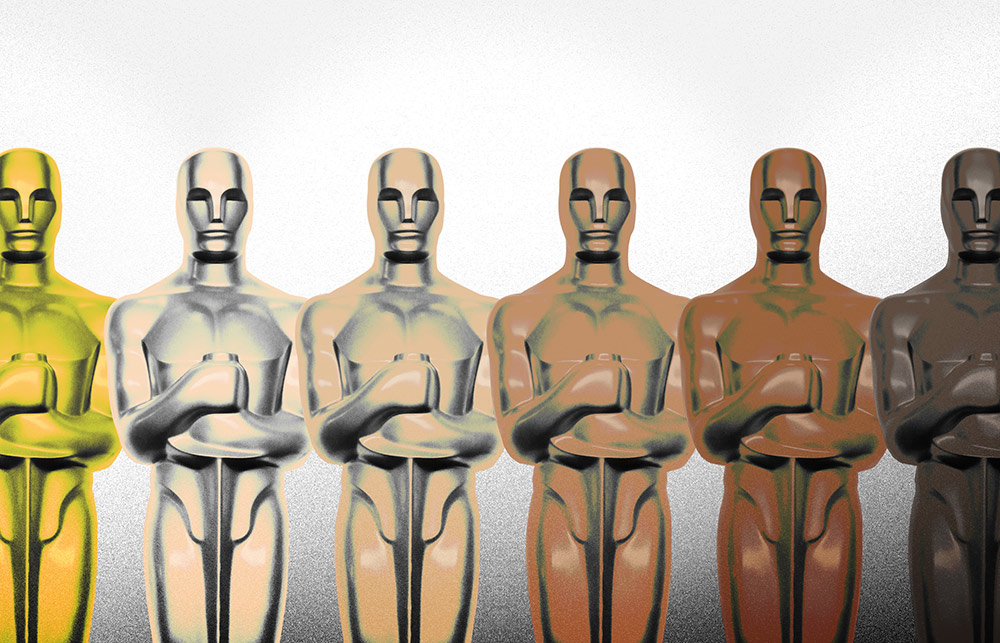
近年來,多元性,、公平性和包容性問題已經(jīng)成為好萊塢關(guān)注的焦點,。一些社會組織——例如亞太娛樂聯(lián)盟(Coalition of Asian Pacifics in Entertainment)和吉娜·戴維斯媒體性別研究所(Geena Davis Institute on Gender in Media)等也一直站在平權(quán)前線發(fā)聲,要求更公平的代表權(quán),。
但以前的奧斯卡獎并非如此,。實際上,在2015年的奧斯卡幾類主要獎項中,,僅有兩部由少數(shù)族裔(BIPOC,即黑人,、印第安人,、有色人種)電影人制作的影片獲得了提名。這讓人們紛紛開始傳播“奧斯卡獎太白了”(#OscarsSoWhite)的話題,,批評該獎項缺乏多元性,。
六年后,奧斯卡獎在提名的包容性方面取得了長足的進步,。但是,,如果該獎項想要更準(zhǔn)確地反映其受眾的多樣性,就依然有很多改進的余地。
今年的提名可能反映了奧斯卡的評審機構(gòu)(即美國電影藝術(shù)與科學(xué)學(xué)院)終于做出了更加多元化的選擇,。兩名女性首次獲得最佳導(dǎo)演提名:《無依之地》(Nomadland)的導(dǎo)演趙婷和《前程似錦的女孩》(Promising Young Woman)的導(dǎo)演埃默拉爾德·芬內(nèi)爾,。史蒂文·元憑借《米納里》(Minari)中的雅各布一角,成為首位獲得奧斯卡最佳男主角提名的亞裔美國人,。和他一起創(chuàng)造歷史的還有巴基斯坦裔的英國演員里茲·阿邁德——憑借《金屬之聲》(Sound of Metal)中的表演,,他成為歷史上第一位獲得最佳男主角提名的穆斯林。獲得最佳影片提名的《猶大和黑彌賽亞》(Judas and the Black Messiah)則是該獎項中首部完全由黑人團隊制作的電影,。
在“奧斯卡太白了”的抗議之后,,該學(xué)院還對終身投票權(quán)做出調(diào)整,增加了新的管理席位,,并重組了委員會,。他們在2016年設(shè)定的目標(biāo)是:到2020年,女性和少數(shù)族裔成員的數(shù)量要增加一倍,。奧斯卡獎成員和管理委員會主席楊燕子(Janet Yang)表示,,該機構(gòu)已經(jīng)實現(xiàn)了少數(shù)族裔成員數(shù)量的目標(biāo),并已經(jīng)接近實現(xiàn)女性成員數(shù)量達(dá)到里程碑式級別的目標(biāo),。
此外,,為了幫助電影界少數(shù)族裔的“明日之星”,學(xué)院也做出了可圈可點的工作,。 2017年,,它推出了一個“奧斯卡獎金色大師計劃”(Academy Gold),面向那些嚴(yán)重缺乏多元性的地方的學(xué)生和年輕從業(yè)者,,旨在為他們在娛樂行業(yè)中謀得更好的實習(xí)機會和指導(dǎo),。
最后,作為“奧斯卡之光2025”計劃(Academy’s Aperture 2025)的一部分,,美國電影藝術(shù)與科學(xué)學(xué)院在2020年宣布了有關(guān)奧斯卡獎入選資格和標(biāo)準(zhǔn)的新規(guī)定,。該倡議并非完美無瑕,但是出臺新的編纂標(biāo)準(zhǔn)這一行為表明,,學(xué)院正在走向多元化,、公平和包容性方面積極努力,而不只是停留在喊口號層面,,并且承認(rèn)了自己在過去確實以白人男性為中心,。
但是,在該學(xué)院成立伊始,,就是白人(2015年占92%)和男性(占75%)主導(dǎo),,整個組織在這方面的進步也很緩慢。即便他們目前還在吸納身份更加多元化的新成員,,該學(xué)院也永遠(yuǎn)無法代表所有美國人口,,因為其新的組織中平均有46%的女性和31%的有色人種,而美國全體人口中有50.5%的女性和39.6%的有色人種。
截至2020年,,美國電影藝術(shù)與科學(xué)學(xué)院的成員仍然是84%的白人和68%的男性,,他們的平均年齡為62歲。因此,,年老的白人仍然在電影業(yè)中擁有絕對權(quán)威,。盡管學(xué)院里的女性比過去要多得多,但她們都來自好萊塢那些女性占比已經(jīng)很高的工作,,例如服裝設(shè)計師(83%),、選角導(dǎo)演(83%)和市場營銷或公關(guān)從業(yè)者(63%)。
學(xué)院的多樣性舉措值得稱贊,,但希望它不會因此而驕傲自滿,,它還要繼續(xù)擴大邊緣群體的聲音。要知道,,刻板印象式的媒介呈現(xiàn)會影響到現(xiàn)實世界,。研究表明,如果電視上的黑人角色一直做出很多非語言的負(fù)面行為,,就會在無形中加深觀眾的種族偏見,。另一項研究發(fā)現(xiàn),看電視會傷害黑人男孩和女孩,,以及白人女孩的自尊心,。
但是通過為平權(quán)運動做出切實的努力、給予這一問題更多關(guān)注,、各方協(xié)同合作,,我們就可以帶來真正的改變。一項研究發(fā)現(xiàn),,每周都和非裔和華裔接觸的小學(xué)生更愿意去和不同種族的孩子互動,。
電影業(yè)界和學(xué)界在道義上的責(zé)任是講故事——講的是能夠準(zhǔn)確反映出觀眾在日常生活中細(xì)微差別的故事。如果覺得這種道義上的理由沒有說服力,,就不妨從生意經(jīng)上考慮,。
“真正以亞太地區(qū)為背景的故事有十分旺盛的市場?!睂W(xué)院成員楊燕子創(chuàng)辦了非營利組織Gold House,,旨在亞太地區(qū)的創(chuàng)業(yè)者和企業(yè)領(lǐng)導(dǎo)人提供職業(yè)生涯支持。
根據(jù)我們學(xué)者和創(chuàng)作者中心(Center for Scholars & Storytellers)以及麥肯錫(McKinsey)新發(fā)布的一份報告中的數(shù)據(jù),,制作具有包容性的多元文化內(nèi)容不僅可以給亞太電影界帶來切實可觀的經(jīng)濟利益,還能夠?qū)φ麄€行業(yè)的少數(shù)族裔都很有利,。在這一點上,,我們希望學(xué)院和整個好萊塢都可以考慮一下他們的道義責(zé)任,并為提高多樣性和包容性的行動提供經(jīng)濟上的支持,以做出實質(zhì)性的改變,。(財富中文網(wǎng))
杰里米·興(Jeremy Hsing)是加州大學(xué)洛杉磯分校(UCLA)的學(xué)生,,也是學(xué)者與創(chuàng)作者中心的研究助理。
亞爾達(dá)·烏爾斯(Yalda T. Uhls)是學(xué)者與創(chuàng)作者中心的創(chuàng)始人,。
編譯:陳聰聰
近年來,,多元性、公平性和包容性問題已經(jīng)成為好萊塢關(guān)注的焦點,。一些社會組織——例如亞太娛樂聯(lián)盟(Coalition of Asian Pacifics in Entertainment)和吉娜·戴維斯媒體性別研究所(Geena Davis Institute on Gender in Media)等也一直站在平權(quán)前線發(fā)聲,,要求更公平的代表權(quán)。
但以前的奧斯卡獎并非如此,。實際上,,在2015年的奧斯卡幾類主要獎項中,僅有兩部由少數(shù)族裔(BIPOC,,即黑人,、印第安人、有色人種)電影人制作的影片獲得了提名,。這讓人們紛紛開始傳播“奧斯卡獎太白了”(#OscarsSoWhite)的話題,,批評該獎項缺乏多元性。
六年后,,奧斯卡獎在提名的包容性方面取得了長足的進步,。但是,如果該獎項想要更準(zhǔn)確地反映其受眾的多樣性,,就依然有很多改進的余地,。
今年的提名可能反映了奧斯卡的評審機構(gòu)(即美國電影藝術(shù)與科學(xué)學(xué)院)終于做出了更加多元化的選擇。兩名女性首次獲得最佳導(dǎo)演提名:《無依之地》(Nomadland)的導(dǎo)演趙婷和《前程似錦的女孩》(Promising Young Woman)的導(dǎo)演埃默拉爾德·芬內(nèi)爾,。史蒂文·元憑借《米納里》(Minari)中的雅各布一角,,成為首位獲得奧斯卡最佳男主角提名的亞裔美國人。和他一起創(chuàng)造歷史的還有巴基斯坦裔的英國演員里茲·阿邁德——憑借《金屬之聲》(Sound of Metal)中的表演,,他成為歷史上第一位獲得最佳男主角提名的穆斯林,。獲得最佳影片提名的《猶大和黑彌賽亞》(Judas and the Black Messiah)則是該獎項中首部完全由黑人團隊制作的電影。
在“奧斯卡太白了”的抗議之后,,該學(xué)院還對終身投票權(quán)做出調(diào)整,,增加了新的管理席位,并重組了委員會,。他們在2016年設(shè)定的目標(biāo)是:到2020年,,女性和少數(shù)族裔成員的數(shù)量要增加一倍。奧斯卡獎成員和管理委員會主席楊燕子(Janet Yang)表示,,該機構(gòu)已經(jīng)實現(xiàn)了少數(shù)族裔成員數(shù)量的目標(biāo),,并已經(jīng)接近實現(xiàn)女性成員數(shù)量達(dá)到里程碑式級別的目標(biāo),。
此外,為了幫助電影界少數(shù)族裔的“明日之星”,,學(xué)院也做出了可圈可點的工作,。 2017年,它推出了一個“奧斯卡獎金色大師計劃”(Academy Gold),,面向那些嚴(yán)重缺乏多元性的地方的學(xué)生和年輕從業(yè)者,,旨在為他們在娛樂行業(yè)中謀得更好的實習(xí)機會和指導(dǎo)。
最后,,作為“奧斯卡之光2025”計劃(Academy’s Aperture 2025)的一部分,,美國電影藝術(shù)與科學(xué)學(xué)院在2020年宣布了有關(guān)奧斯卡獎入選資格和標(biāo)準(zhǔn)的新規(guī)定。該倡議并非完美無瑕,,但是出臺新的編纂標(biāo)準(zhǔn)這一行為表明,,學(xué)院正在走向多元化、公平和包容性方面積極努力,,而不只是停留在喊口號層面,,并且承認(rèn)了自己在過去確實以白人男性為中心。
但是,,在該學(xué)院成立伊始,,就是白人(2015年占92%)和男性(占75%)主導(dǎo),整個組織在這方面的進步也很緩慢,。即便他們目前還在吸納身份更加多元化的新成員,,該學(xué)院也永遠(yuǎn)無法代表所有美國人口,因為其新的組織中平均有46%的女性和31%的有色人種,,而美國全體人口中有50.5%的女性和39.6%的有色人種,。
截至2020年,美國電影藝術(shù)與科學(xué)學(xué)院的成員仍然是84%的白人和68%的男性,,他們的平均年齡為62歲,。因此,年老的白人仍然在電影業(yè)中擁有絕對權(quán)威,。盡管學(xué)院里的女性比過去要多得多,,但她們都來自好萊塢那些女性占比已經(jīng)很高的工作,例如服裝設(shè)計師(83%),、選角導(dǎo)演(83%)和市場營銷或公關(guān)從業(yè)者(63%),。
學(xué)院的多樣性舉措值得稱贊,但希望它不會因此而驕傲自滿,,它還要繼續(xù)擴大邊緣群體的聲音,。要知道,刻板印象式的媒介呈現(xiàn)會影響到現(xiàn)實世界,。研究表明,,如果電視上的黑人角色一直做出很多非語言的負(fù)面行為,,就會在無形中加深觀眾的種族偏見,。另一項研究發(fā)現(xiàn),,看電視會傷害黑人男孩和女孩,以及白人女孩的自尊心,。
但是通過為平權(quán)運動做出切實的努力,、給予這一問題更多關(guān)注、各方協(xié)同合作,,我們就可以帶來真正的改變,。一項研究發(fā)現(xiàn),每周都和非裔和華裔接觸的小學(xué)生更愿意去和不同種族的孩子互動,。
電影業(yè)界和學(xué)界在道義上的責(zé)任是講故事——講的是能夠準(zhǔn)確反映出觀眾在日常生活中細(xì)微差別的故事,。如果覺得這種道義上的理由沒有說服力,就不妨從生意經(jīng)上考慮,。
“真正以亞太地區(qū)為背景的故事有十分旺盛的市場,。”學(xué)院成員楊燕子創(chuàng)辦了非營利組織Gold House,,旨在亞太地區(qū)的創(chuàng)業(yè)者和企業(yè)領(lǐng)導(dǎo)人提供職業(yè)生涯支持,。
根據(jù)我們學(xué)者和創(chuàng)作者中心(Center for Scholars & Storytellers)以及麥肯錫(McKinsey)新發(fā)布的一份報告中的數(shù)據(jù),制作具有包容性的多元文化內(nèi)容不僅可以給亞太電影界帶來切實可觀的經(jīng)濟利益,,還能夠?qū)φ麄€行業(yè)的少數(shù)族裔都很有利,。在這一點上,我們希望學(xué)院和整個好萊塢都可以考慮一下他們的道義責(zé)任,,并為提高多樣性和包容性的行動提供經(jīng)濟上的支持,,以做出實質(zhì)性的改變。(財富中文網(wǎng))
杰里米·興(Jeremy Hsing)是加州大學(xué)洛杉磯分校(UCLA)的學(xué)生,,也是學(xué)者與創(chuàng)作者中心的研究助理,。
亞爾達(dá)·烏爾斯(Yalda T. Uhls)是學(xué)者與創(chuàng)作者中心的創(chuàng)始人。
編譯:陳聰聰
In the past few years, diversity, equity, and inclusion has become a front-and-center issue for Hollywood. Organizations such as the Coalition of Asian Pacifics in Entertainment and the Geena Davis Institute on Gender in Media have been leading the way in demanding more equitable representation.
But it wasn’t always that way. In fact, in 2015, only two movies by a Black, Indigenous, or person of color (BIPOC) filmmaker were nominated in major categories at the Oscars. This led to the trending hashtag #OscarsSoWhite, created to call out the Academy for its lack of diversity.
Six years later, the Academy has come a long way in becoming more inclusive in its nominations. However, there is still much room for improvement if the Academy wants to accurately reflect the diversity of its viewership.
This year’s nominations may finally reflect the choices of a more diverse Academy membership. Two women are nominated for best director for the first time ever: Chloé Zhao (Nomadland) and Emerald Fennell (Promising Young Woman). Steven Yeun is the first Asian American ever nominated for the best actor Oscar for his performance as Jacob in Minari. He is joined by the British-Pakistani actor Riz Ahmed, who made history becoming the first Muslim nominated for best actor in Sound of Metal. And Judas and the Black Messiah has the first all-Black production team to be nominated for best picture.
After #OscarsSoWhite, the Academy reframed lifetime voting rights, added new governor seats, and restructured committees. Its goal in 2016 was to double the number of women and BIPOC members by 2020. Janet Yang, chair of the membership and governance committee at the Academy, told us that the institution has met its goal for BIPOC and is close to meeting the milestone for women.
Moreover, the Academy has done an admirable job to help the BIPOC filmmakers of tomorrow. In 2017, it created Academy Gold, an entertainment industry–wide internship enhancement and mentorship program for students and young professionals from underrepresented communities.
Lastly, in 2020 the Academy announced new representation and inclusion standards for Oscars eligibility as part of its Academy Aperture 2025 initiative. The initiative isn’t perfect, but the act of codifying standards shows the Academy’s positive trajectory toward diversity, equity, and inclusion beyond tokenism, as well as its acknowledgement of its white male–centric past.
However, the organization began from a place of such whiteness (92% in 2015) and maleness (75%) that its overall composition is evolving slowly. Even if the group continues to invite members at this current, far more inclusive rate, the Academy would never be representative of the U.S. population, because its new classes have averaged 46% female and 31% people of color, while the U.S. overall is 50.5% female and 39.6% people of color.
As of 2020, Academy membership was still 84% white and 68% male, and the average age of an Academy member was 62. Thus, older white men still hold the positions of power and influence in the film industry. And while the Academy’s female numbers are much larger than in the past, they are drawn from Hollywood jobs that already have heavy female representation, such as costume designers (83%), casting directors (83%), and marketing or PR professionals (63%).
The Academy deserves credit for its diversity initiatives, but hopefully it will not become complacent and will continue to amplify the voices of marginalized communities. Stereotypical representation has real-world implications. Research shows that watching TV characters express negative nonverbal behavior toward Black characters increases viewers’ unconscious race bias. Another study found that watching TV decreased the self-esteem of Black boys and girls and white girls.
But with work, attention, and collaboration, we can make a real difference. One study found that elementary school children exposed to weekly stories featuring African and Chinese characters were more interested in interacting with children different from their own race.
It is the moral responsibility of filmmakers and scholars to tell stories that accurately reflect the everyday nuances of their audiences. But if the moral argument doesn’t sway you, then consider the business imperative.
“There is a robust market for authentic AAPI [Asian American and Pacific Islander] stories,” said Academy member Yang, who cofounded Gold House, a nonprofit supporting the careers of AAPI founders and leaders.
Data released by our organization, the Center for Scholars & Storytellers, and a newly published McKinsey report indicate that making inclusive multicultural content isn’t just financially beneficial for the AAPI filmmaking community, but all BIPOC in the industry. With this in mind, our hope is for the Academy and Hollywood at large to consider both their morality as well as the financial upside of implementing substantial changes with regard to diversity and inclusion.
Jeremy Hsing is a student at UCLA and a research assistant at the Center for Scholars & Storytellers.
Yalda T. Uhls is the founding director of the Center for Scholars & Storytellers.






